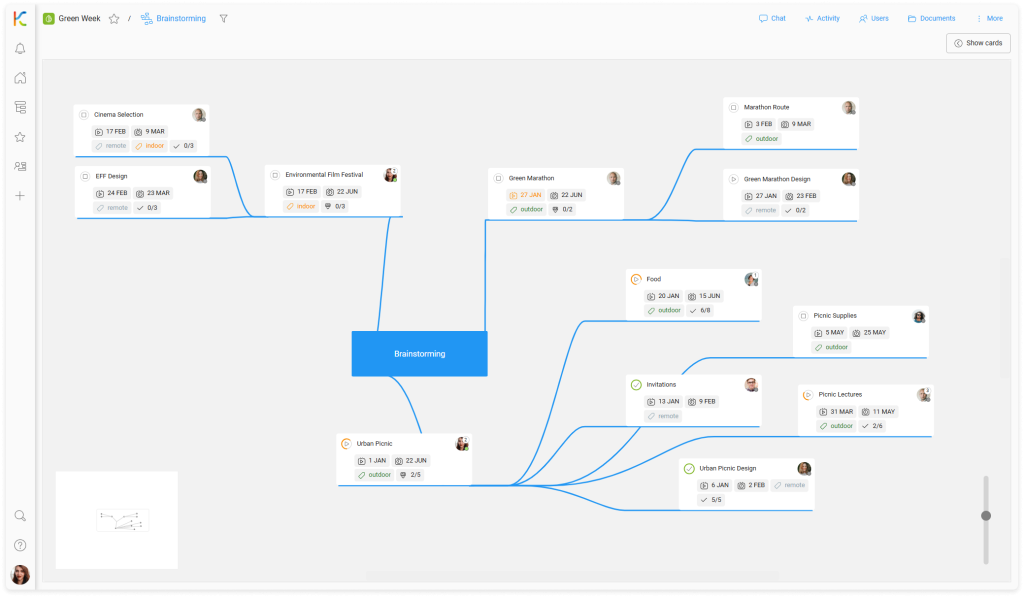Overview
KanBo Getting Started
6. Card Relations
Learn KanBo > Getting Started with KanBo > Card Relations
Learn KanBo > Getting Started with KanBo > Card Relations
Card Relations
Card relations are connections between cards, that show how they depend on each other. You can add Parent & Child relation to break down complex tasks into smaller, more manageable components, or connect cards with Next & Previous relation to determine the order of tasks. Use them to manage dependencies between tasks and resolve potential scheduling conflicts.
The steps in the video are also described in the following sections.
Article
Card Relations
In this article:
Relations between cards
Card relations are connections between cards that show how they depend on each other.
There are two types of card relations in KanBo:

 Parent-child relation – to break complex tasks into smaller ones
Parent-child relation – to break complex tasks into smaller ones
 Next-previous relation – to determine the order of tasks
Next-previous relation – to determine the order of tasks
Card relations help to understand the hierarchy between cards and to coordinate work in time.
Parent & child card relation
The parent-child card relation represents a hierarchical structure in which a card is associated with one or more subcards. Subcards can represent tasks that result from the parent card.
It’s important to note that subcards are regular cards, but they are dependent on the parent card.
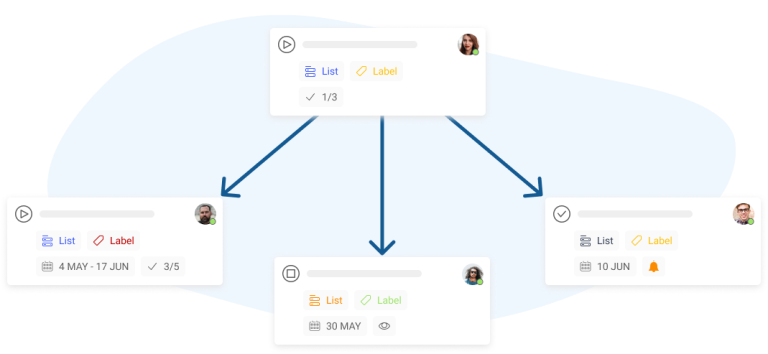
Sometimes a card may describe a project that consists of smaller tasks for different users. Then these tasks can be presented as subcards.
Example: Mind Map view is a perfect way to visualize parent-child card relations.
Subwork
Each card has a special tab dedicated to subcards – Subwork tab.
All subcards can be found in the Subwork tab, where they can be lumped together or grouped using subcard groups. Here we can add a new card or remove the parent-child connection.
When you open any subcard, you will see that it is just a regular card. You can assign users or add items to this card, including other subcards, resulting in creating a tree of relations between cards.
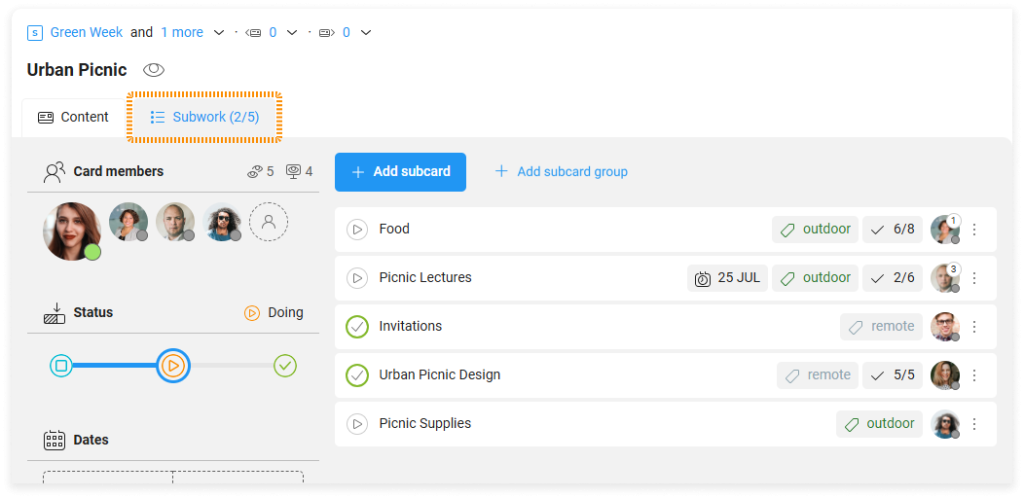
Example: The Subwork tab is present in every card.
You can also create subcard groups and display them in card elements section in card content.
Next & previous card relation
The next-previous card relation is a logical dependency between cards. The previous card must be completed before the next card can begin. This illustrates the cause-and-effect sequence between tasks. Time is the essence of this relation.
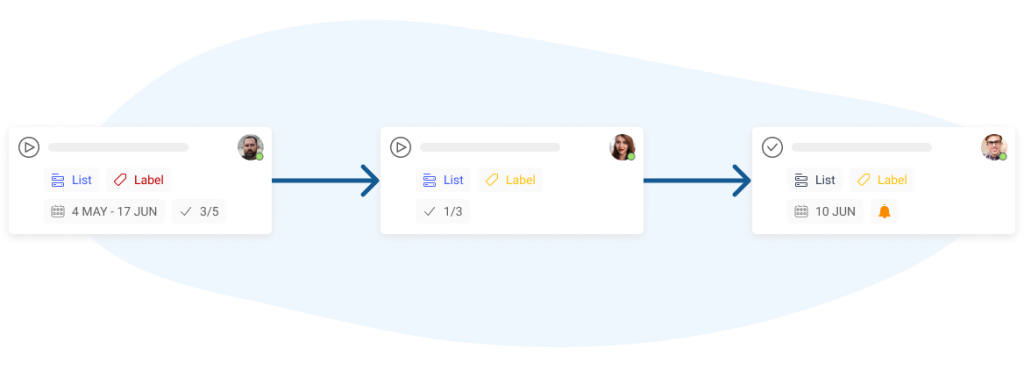
Presenting the cards in the form of sequential steps to be performed helps to understand and emphasize the importance of each user’s work.

Example: The card top bar shows information about the number of next and previous cards.
Time dependencies in card relations
We already know that the previous card should be completed before the next card begins. But what if it doesn’t?
In that case, we have a date conflict issue. The next cards is marked with an orange warning. We can check its details inside the card. It informs about possible delays. The warning will disappear when we correct the schedule of our cards, or when the previous task is completed.
Time dependencies also apply to parent-child relations. All child cards must be completed during the parent card. Otherwise, on-time project delivery will be at risk.
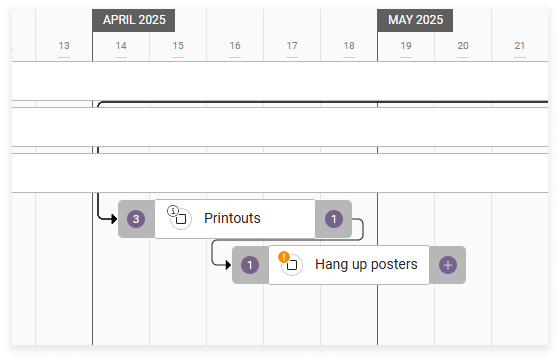
Example: The best way to visualize time dependencies in card relations is the Gantt Chart view.
In this way, KanBo helps you identify potential performance problems. Set a logical relation for each card and get a new view of the dependencies between your tasks. This is a fantastic tool that makes it easier to plan and coordinate the work of your team.
Follow the video step-by-step
Open your space using Sidebar and ![]() Workspaces & Spaces to follow the instructions.
Workspaces & Spaces to follow the instructions.
First, we can see the Mind Map view.
- On the top space bar, go to the space view, and then select Mind Map.
See how to create a Mind Map view.
Then we go to the Kanban view.
- On the top space bar, go to the space view, and then select Kanban.
See how to create a Kanban view.
Card types in Kanban view
- On the top space bar, select
 Display settings, go to Card types, and switch the toggle next to Show subcards.
Display settings, go to Card types, and switch the toggle next to Show subcards.
- On the card front, select the
 card icon.
card icon.
OR
- On the top space bar, select
 Display settings, and switch the toggle next to Expand child cards.
Display settings, and switch the toggle next to Expand child cards.
Creating subcards
To create a subcard:
- Open a card, and go to Subwork tab.
- Select + Add subcard.
- Enter the name (other fields are optional), then select Add subcard.
Creating next cards
To create the next card:
- Open a card.
- On the card top bar, select the
 next card icon.
next card icon. - Select + Add next card.
- Enter the name (other fields are optional), then select Add relation.
Adding previous cards
To add the existing card as a previous one:
- Open the card.
- On the card top bar, select the
 previous card icon.
previous card icon. - Select + Add previous card.
- Go to Search for card tab.
- Enter the query.
- Select the card and confirm using the Add relation button.
Date dependencies in Gantt Chart view
Then we go to the Gantt Chart view.
- On the top space bar, go to the space view, and then select Kanban.
See how to create a Gantt Chart view.
To expand/hide subcards on a Gantt Chart view:
- Select the triangle icon on the left of the card.
To create the next card with card dates:
- Open a card.
- On the card top bar, select the
 next card icon.
next card icon. - Select + Add next card.
- Enter the name, select the
 Start date, and
Start date, and  Due date from the calendar, and then select
Due date from the calendar, and then select  Save.
Save. - Select Add relation.
To reschedule the card:
- Drag a card and move it to another position.
Follow the video step-by-step
Open your space using Sidebar and ![]() Workspaces & Spaces to follow the instructions.
Workspaces & Spaces to follow the instructions.
First, we can see the Mind Map view.
- On the top space bar, go to the space view, and then select Mind Map.
See how to create a Mind Map view.
Then we go to the Kanban view.
- On the top space bar, go to the space view, and then select Kanban.
See how to create a Kanban view.
Card types in Kanban view
- On the top space bar, select
 Display settings, go to Card types, and switch the toggle next to Show subcards.
Display settings, go to Card types, and switch the toggle next to Show subcards.
- On the card front, select the
 card icon.
card icon.
OR
- On the top space bar, select
 Display settings, and switch the toggle next to Expand child cards.
Display settings, and switch the toggle next to Expand child cards.
Creating subcards
To create a subcard:
- Open a card, and go to Subwork tab.
- Select + Add subcard.
- Enter the name (other fields are optional), then select Add subcard.
Creating next cards
To create the next card:
- Open a card.
- On the card top bar, select the
 next card icon.
next card icon. - Select + Add next card.
- Enter the name (other fields are optional), then select Add relation.
Adding previous cards
To add the existing card as a previous one:
- Open the card.
- On the card top bar, select the
 previous card icon.
previous card icon. - Select + Add previous card.
- Go to Search for card tab.
- Enter the query.
- Select the card and confirm using the Add relation button.
Date dependencies in Gantt Chart view
Then we go to the Gantt Chart view.
- On the top space bar, go to the space view, and then select Kanban.
See how to create a Gantt Chart view.
To expand/hide subcards on a Gantt Chart view:
- Select the triangle icon on the left of the card.
To create the next card with card dates:
- Open a card.
- On the card top bar, select the
 next card icon.
next card icon. - Select + Add next card.
- Enter the name, select the
 Start date, and
Start date, and  Due date from the calendar, and then select
Due date from the calendar, and then select  Save.
Save. - Select Add relation.
To reschedule the card:
- Drag a card and move it to another position.

